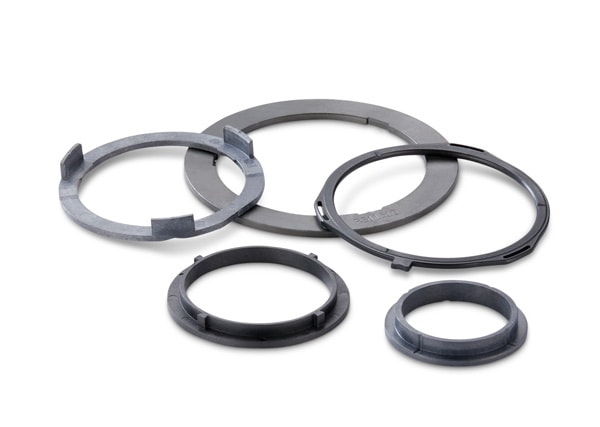
Wall Thickness
- Designing Rubber Components
- Overview
- Working Together
- Engineering Design
- Cost Effective Custom-Molded Seals
- Avoiding Rubber Component Design Problems
- Properties in Balance
- Selecting an Elastomeric Material
- Elastomer Hardness Selection
- Where to Start
- Corners and Edges
- Undercuts
- Holes
- Sharp Edges
- Circularity
- Total Indicator Reading
- Rubber Over-Molding
- Standard Tolerance Chart
- Rubber Molding Considerations
- Building the Mold
- Molding Processes
- Deflashing
- Gates
- Feed Examples
- Building a Prototype
- Selecting the Mold
- Parts Assembly and Prototype Testing
- Specifying Metal Parts
- CAD Data Interchange Capabilities
- Elastomers/Materials
- Overview
- Polymer Types
- Acrylonitrile / Butadiene
- Highly Saturated Nitrile
- Nitrile / PVC Resin Blends
- Fluorocarbon
- Ethylene Propylene Diene Monomer
- Styrene Butadiene
- Polychloroprene
- Isobutylene Isoprene Rubber
- Silicones
- Fluorosilicone
- Polyacrylate
- Ethylene Acrylic
- Chlorosulfonated Polyethylene
- Epichlorohydrin
- Polyisoprene
- Polyurethane
- Polybutadiene
- Special Compounds & Certifications
- Wear Resistant/ Lubricated Compounds
- Quniton®
- FDA Regulations/Food & Beverage Applications
- UL Listed Compounds
- NSF International® Potable Water Applications (ANSI/NSF Standard 61)
- International Certifications – Potable Water
- Rubber Resistance to Chlorine and Other Water Treatment Chemicals
- Perfluoroelastomers
- Medical and Laboratory Requirements
- Taste and Odor Specifications
- FKM Compounds for Fuel and Chemical Industries
- Computer Applications
- Designing Plastic Components
- Plastic & Thermoplastic Materials
- Rubber Standard Parts
- Overview
- Rubber Standard Profiles
- The Quad® Brand Seal Family
- Identifying A Sealing Application Type
- Defining Factors in Sealing Applications
- Quad-Ring® Brand Seals
- Groove Design: Quad-Ring® Seals
- Quad® Brand O-Ring Seals
- Groove Design: O-Ring Seals
- Piston Seal Application Example
- Rod Seal Application Example
- Quad-Ring® Brand and O-Ring Seals for Face Seal Applications
- Quad-Ring® Face Seal Application Example
- Rotary Seals
- Sealing Systems Rotary Seal Application
- Quad-Ring® Brand Seals for Rotary Applications With Oil
- Quad-Ring® Brand Rotary Seal Application
- Selection Guide/Standard Size Quad-Ring® Brand Seals and Quad® Brand O-Rings Seals
- Quad® Brand Ground Rubber Balls
- Equi-Flex™ Rod Wiper/ Scraper
- Quad® P.E. Plus Brand Plastic Exclusion Seals
- Glossary of Terms
- Pawling Products
- Overview
- Inflatable Seals and Clamps
- Inflatable Seal Standard Profiles
- Q Standard Profiles
- Inflatable Seal and Clamp Construction
- Inflatable Seal and Clamp Configurations
- Recommended Inflatable Sealing Gap
- Inflatable Seal Corner Details
- Inflatable Clamp (or Seal) End Designs
- Inflatable Seal Air Connectors
- Universal Air Connectors
- Inflatable Seal and Clamp Custom Capabilities
- Compression Seals & Gaskets
- Septa
- Materials
Uniform wall thickness is critical in part design for an injection molded part.
Non-uniform wall thickness causes dimensional control problems, warpage and other part integrity issues
Production techniques on thin walls become quite complicated. For efficient, high volume production, we recommend a minimum wall thickness of 0.025 – 0.030 (0.635 – 0.762mm) on small parts, 0.040 – 0.050 (1.02 – 1.27mm) on larger parts.